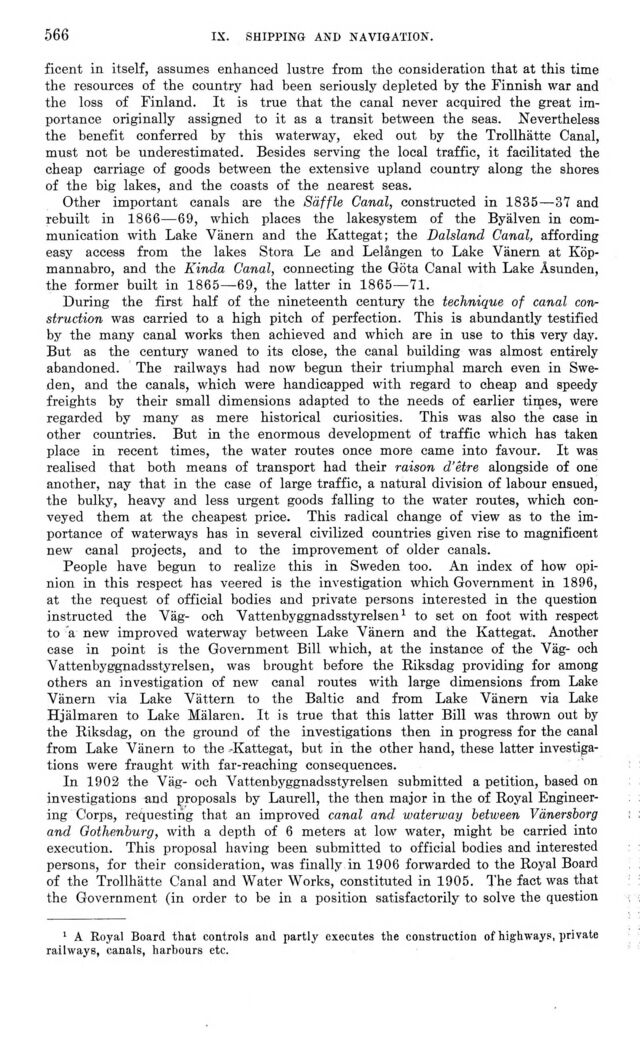
Full resolution (JPEG) - On this page / på denna sida - IX. Shipping and Navigation. By H. Rosman - Canals and Waterways. By F. V. Hansen

<< prev. page << föreg. sida << >> nästa sida >> next page >>
Below is the raw OCR text
from the above scanned image.
Do you see an error? Proofread the page now!
Här nedan syns maskintolkade texten från faksimilbilden ovan.
Ser du något fel? Korrekturläs sidan nu!
This page has never been proofread. / Denna sida har aldrig korrekturlästs.
■566
ix. shipping and navigation.
ficent in itself, assumes enhanced lustre from the consideration that at this time
the resources of the country had been seriously depleted by the Finnish war and
the loss of Finland. It is true that the canal never acquired the great
importance originally assigned to it as a transit between the seas. Nevertheless
the benefit conferred by this waterway, eked out by the Trollhätte Canal,
must not be underestimated. Besides serving the local traffic, it facilitated the
cheap carriage of goods between the extensive upland country along the shores
of the big lakes, and the coasts of the nearest seas.
Other important canals are the Säffle Canal, constructed in 1835—37 and
rebuilt in 1866—69, which places the lakesystem of the Byälven in
communication with Lake Vänern and the Kattegat; the Dalsland Canal, affording
easy access from the lakes Stora Le and Lelången to Lake Vänern at
Köpmannabro, and the Kinda Canal, connecting the Göta Canal with Lake Åsunden,
the former built in 1865—69, the latter in 1865—71.
During the first half of the nineteenth century the technique of canal
construction was carried to a high pitch of perfection. This is abundantly testified
by the many canal works then achieved and which are in use to this very day.
But as the century waned to its close, the canal building was almost entirely
abandoned. The railways had now begun their triumphal march even in
Sweden, and the canals, which were handicapped with regard to cheap and speedy
freights by their small dimensions adapted to the needs of earlier tinges, were
regarded by many as mere historical curiosities. This was also the case in
other countries. But in the enormous development of traffic which has taken
place in recent times, the water routes once more came into favour. It was
realised that both means of transport had their raison d’etre alongside of one
another, nay that in the case of large traffic, a natural division of labour ensued,
the bulky, heavy and less urgent goods falling to the water routes, which
conveyed them at the cheapest price. This radical change of view as to the
importance of waterways has in several civilized countries given rise to magnificent
new canal projects, and to the improvement of older canals.
People have begun to realize this in Sweden too. An index of how
opinion in this respect has veered is the investigation which Government in 1896,
at the request of official bodies and private persons interested in the question
instructed the Väg- och Vattenbyggnadsstyrelsen1 to set on foot with respect
to a new improved waterway between Lake Vänern and the Kattegat. Another
case in point is the Government Bill which, at the instance of the Väg- och
Vattenbyggnadsstyrelsen, was brought before the Riksdag providing for among
others an investigation of new canal routes with large dimensions from Lake
Vänern via Lake Vättern to the Baltic and from Lake Vänern via Lake
Hjälmaren to Lake Mälaren. It is true that this latter Bill was thrown out by
the Riksdag, on the ground of the investigations then in progress for the canal
from Lake Vänern to the -Kattegat, but in the other hand, these latter
investigations were fraught with far-reaching consequences.
In 1902 the Väg- och Vattenbyggnadsstyrelsen submitted a petition, based on
investigations and proposals by Laurell, the then major in the of Royal
Engineering Corps, requesting that an improved canal and waterway between Vänersborg
and Gothenburg, with a depth of 6 meters at low water, might be carried into
execution. This proposal having been submitted to official bodies and interested
persons, for their consideration, was finally in 1906 forwarded to the Royal Board
of the Trollhätte Canal and Water Works, constituted in 1905. The fact was that
the Government (in order to be in a position satisfactorily to solve the question
1 A Royal Board that controls and partly executes the construction of highways, private
railways, canals, harbours etc.
<< prev. page << föreg. sida << >> nästa sida >> next page >>